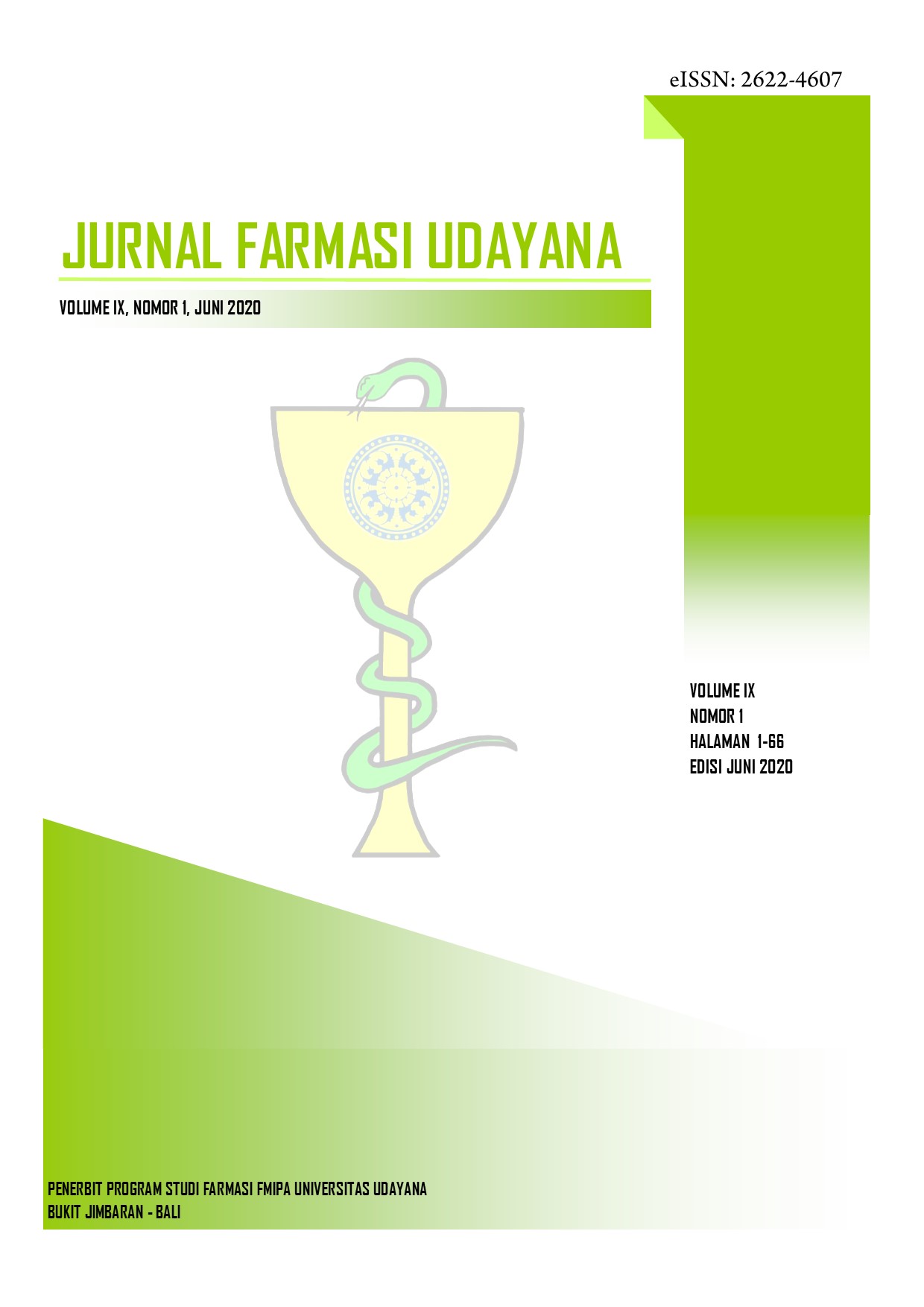Aktivitas Antibakteri Ekstrak Etanol Daun Kapas (Gossypium barbadense L.) terhadap Staphylococcus epidermidis dan Propionibacterium acnes
Abstract
Gossypium barbadense L. is one of the plants that has the potential to be developed into an antibacterial agent. This study aims to determine the antibacterial ability of chemical compounds in ethanol extract of Gossypium barbadense L. leaves to Staphylococcus epidermidis and Propionibacterium acnes bacteria which are characterized by the formation of inhibitory zones. Extraction of Gossypium barbadense L. leaves was carried out by maceration using 96% ethanol. Antibacterial activity testing was carried out by agar diffusion method with a cylinder plate technique and the extract was made a concentration series. TLC bioautography and chromogenic reagents are used in the identification of groups of compounds that have antibacterial activity. The results showed that the ethanol extract of Gossypium barbadense L. leaves gave the greatest inhibition at 70% extract concentration ie 11.40 ± 0.32 mm against Propionibacterium acnes and 50% extract concentration against Staphylococcus epidermidis bacteria which was 12.28 ± 0.63 mm. The group of compounds that are thought to be responsible for antibacterial activity are flavonoids.
Keywords: Antibacterial, Gossypium barbadense L. Leaves, Propionibacterium acnes, Staphylococcus epidermidis
Downloads
References
2. Essien EE, Aboaba SO, Isiaka A, Ogunwande IA. Constituents and antimicrobial properties of the leaf essential oil of Gossypium barbadense (Linn.) Journal of Medicinal Plants Research. 2011. 5(5): 702–705.
3. Ikobi E, Igwilo CI, Awodele O, Azubuike C. Antibacterial and wound healing properties of methanolic extract of dried fresh Gossypium barbadense Leaves. Asian Journal of Biomedical and Pharmaceutical Science. 2012. 2 (13):32- 37.
4. Saidu TB, Abdullahi M. Phytochemical determinations and antibacterial activities of the leaf extracts of Combretum molle and Gossypium arboreum, Bayero Journal of Pure and Applied Sciences. 2011.4(2): 132 – 136. http://dx.doi.org/10.4314/bajopas.v4i2.26.
5. Annan K, Houghton PJ. Antibacterial, antioxidant and fibroblast growth stimulation of aqueous extracts of Ficus asperifolia Miq. and Gossypium arboreum L., wound-healing plants of Ghana. J Ethnopharmacol. 2008. 119:141-44. https://doi.org/10.1016/j.jep.2008.06.017.
6. Kumar B, Pathak R, Mary PB, Jha D, Sardana K, & Gautam HK, New insights into acne pathogenesis: Exploring the role of acne-associated microbial populations, Dermatologica Sinica. 2016. 34 : 67-73, https://doi.org/10.1016/j.dsi.2015.12.004
7. Dhillon KS & Varshney KR. Study of Microbiological Spectrum in Acne Vulgaris: An In Vitro Study. Scholars Journal of Applied Medical Sciences . 2013. 1(6):724-727.
8. Katsambas A, & Dessinioti C. New and emerging treatments in dermatology: acne. dermatologic therapy. 2008. 21: 86–95.
9. Prasad SB. Acne vulgaris: a review on pathophysiology and treatment. Asian Journal of Pharmaceutical Clinical Research. 2016. 9(4):54-59.
10. Fabbrocini G, Annunziata MC, D’arco V, De vita V, Lodi G, Mauriello MC, et al. Review article acne scars: Pathogenesis, classification and treatment. Dermatology Research and Practice. 2010:1-13. Article ID 893080. doi:10.1155/2010/893080.
11. Ngajow M, Abidjulu J, Kamu VS. Pengaruh antibakteri ekstrak kulit batang matoa (Pometia pinnata) terhadap bakteri Staphylococcus aureus secara in vitro. Jurnal MIPA UNSRAT Online. 2013. 2 (2):128-132.
12. Murtaningsih S, Nurbaeti SN, Kusharyanti I. Efektivitas gel antijerawat ekstrak metanol daun pacar air (Impatiens balsamina L.) terhadap bakteri Propionibacterium acnes dan Staphylococcus epidermidis secara in vitro. Journal of Tropical Pharmacy and Chemistry. 2014. 2(4): 225-234.
13. Dewanjee S, Gangopadhyay M, Bhattacharya N, Khanra R, & Dua TK. Bioautography and its scope in the field of natural product chemistry. Journal of Pharmaceutical Analysis. 2015. 5(2):75–84, http://dx.doi.org/10.1016/j.jpha.2014.06.002.
14. Choma IM, & Jesionek W. TLC-direct bioautography as a high throughput method for detection of antimicrobials in plants. Chromatography. 2015. 2:225-238. doi:10.3390/chromatography2020225.
15. Nester EW. Microbiology a human perspective 3rd Edition. New York : Mc Graw Hill 2001.
16. Pękal A, & Pyrzynska K. Evaluation of aluminium complexation reaction for flavonoid content assay. Food Analytical Methods. 2014.7(9):1776-1782, doi 10.1007/s12161-014-9814-x.
17. Cushnie TPT, Lamb AJ. Detection of galangin-induced cytoplasmic membrane damage in Staphylococcus aureus by measuring potassium loss. J. Ethnopharmacol. 2005. 101(1-3): 243-248.
18. Ulanowska K, Tkaczyk A, Konopa G, & Wegrzyn G. Differential antibacterial activity of genistein arising from global inhibition of DNA, RNA and protein synthesis in some bacterial strains. Arch. Microbiol. 2006. 184(5):271-278.
19. Eumkeb G, Chukrathok S. Synergistic activity and mechanism of action of ceftazidime and apigenin combination against ceftazidime-resistant Enterobacter cloacae. Phytomedicine. 2013. 20(3-4):262-269.
20. Cushnie TPT, Lamb AJ. Recent advances in understanding the antibacterial properties of flavonoids. Int. J. Antimicrob. Agents. 2011. 38(2):99-107.
21. Xie Y, Yang W, Tang F, Chen X,& Ren L. antibacterial activities of flavonoids: structure-activity relationship and mechanism. Current Medicinal Chemistry. 2015. 22: 132-149. https://doi.org/10.2174/0929867321666140916113443.




